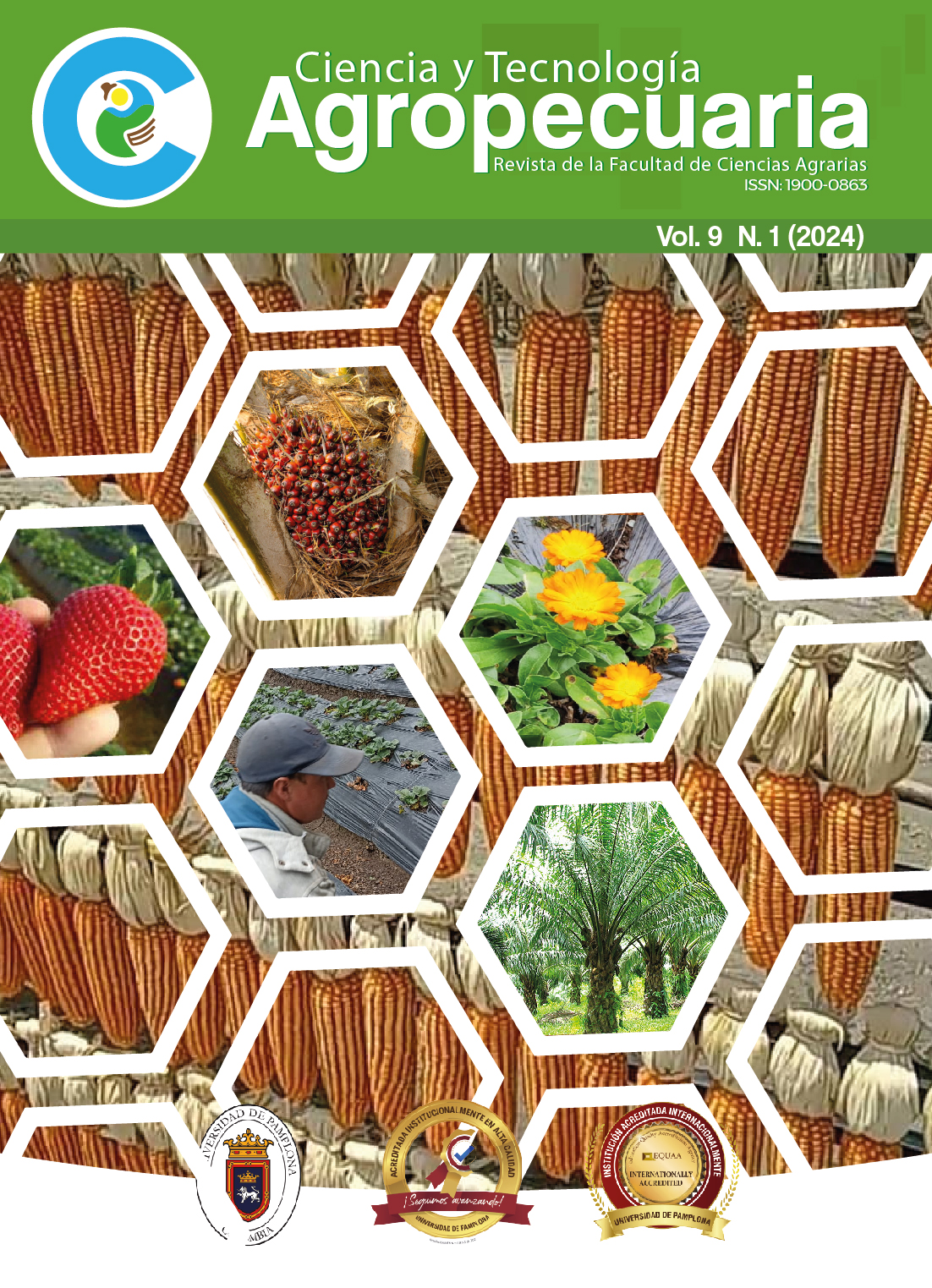Antagonistas comerciales para el manejo de enfermedades fúngicas del cultivo de fresa (Fragaria x ananassa Duch.), en el municipio de Pamplona, Norte de Santander
DOI:
https://doi.org/10.24054/cyta.v9i1.2952Palabras clave:
Bioproductos, enfermedades, control biológico, incidencia, severidadResumen
Las enfermedades fúngicas en los cultivos de fresa son una gran problemática para los agricultores del municipio de Pamplona Norte de Santander, por eso la importancia de buscar posibles soluciones que ayuden a mitigar la incidencia y severidad de estas enfermedades. El objetivo general de este trabajo fue evaluar antagonistas comerciales para el manejo de enfermedades fúngicas en fresa, se realizó un experimento en campo de bloques completos al azar de ocho tratamientos con cuatro repeticiones de los cuales tres fueron fungicidas químicos, la mezcla de los fungicidas químicos, dos tratamientos biológicos, la mezcla de los biológicos y el manejo del agricultor. En los análisis estadísticos no se obtuvieron diferencias estadísticas significativas, pero se logró observar que los productos tuvieron un efecto positivo en el control de estas enfermedades y se destacan principalmente los productos biológicos ya que estos no solo controlan las enfermedades del cultivo, sino que también pueden estimular la planta para su buen desarrollo a diferencia de los productos químicos que son específicos para controlar enfermedades, de la misma manera los productos biológicos son una buena alternativa por que se demuestra que son igual y en algunos casos mejor que los tratamientos químicos.
Descargas
Referencias
Agrios, G. N. (2005). Plant Pathology. Elsevier.
Alzate Pérez, D. (2022). Evaluar dos metodologías para el análisis de residuos de los fungicidas mancozeb y propineb en frutas y vegetales como alternativas de análisis de su calidad e inocuidad. Universidad Nacional de Colombia.
Baldovino Sanjuán, A. (2018). Enfermedades foliares más importantes del cultivo de la fresa en Pamplona, algunas alternativas de control. Recuperado de http://repositoriodspace.unipamplona.edu.co/jspui/handle/20.500.12744/1804
Castellanos, L., Gonzalez-Pedraza, A., Santos, O., Hurtado, A., Becerra, W., & Cespedes, N. (2022). Fortalecimiento de la productividad con alternativas biológicas para la producción más limpia de fresa y alverja con la implementación de BPA en fincas de los productores agrícolas del municipio de Pamplona. Recuperado de https://www.unipamplona.edu.co/unipamplona/portalIG/home_224/recursos/general/22112022/proyecto_bpa.jsp
Ciba Geigy. (1981). Manual for field trials in plant production (2a ed.). Basilea, Suiza. https://doi.org/10.1186/s42483-021-00098-7
Elshafei, A. M., Shishido, M., & Sugiyama, Y. (2020). Biocontrol potential of Trichoderma asperellum against Botrytis cinerea causing strawberry fruit rot. Biological Control, 145, 104262. https://doi.org/10.1016/j.biocontrol.2020.104262
Hernández-Mendoza, F., Carrillo-Castañeda, G., Pedraza- Santos, M. E., De la Cruz Torres, E., & Mendoza- Castillo, M. (2015). Regeneración in vitro de brotes de Polianthes tuberosa L. a partir de yemas vegetativas de la inflorescencia y de tejido de cormo. Nova scientia, 7(13), 32-47.
Larios Larios, E. J., Valdovinos Nava, J. D. J. W., Chan Cupul, W., García López, F. A., Manzo Sánchez, G., & Buenrostro Nava, M. T. (2019). Biocontrol de damping off y promoción del crecimiento vegetativo en plantas de Capsicum chinense (Jacq) con Trichoderma spp. Revista mexicana de ciencias agrícolas, 10(3), 471-483.
López-Mora, A., Maldonado-González, M. M., Hidalgo- Díaz, L., Rosales, R., & Bautista-Baños, S. (2017). Characterization of Bacillus spp. strains for the biocontrol of strawberry fruit anthracnose. Biological Control, 105, 41-48. https://doi.org/10.1016/j.biocontrol.2016.11.010
Mercado-Blanco, J., Abrantes, I., Barra, Carvalho, M., Cerkauskas, R., Cleary, M., ... et al. (2018). Impacts of soil abiotic factors on beneficial soil microbiota used in plant protection. Microbiological Research, 208, 38-51. https://doi.org/10.1016/j.micres.2018.01.001
Rosero Cisneros, N. G. (2011). Efectos de la aplicación de Trichoderma harzianum sobre la incidencia de “damping off” en el cultivo de fresa (Fragaria vesca L.) en la zona del Quinche, Provincia de Pichincha (Tesis de licenciatura). Universidad Técnica de Babahoyo.
Rubio, S. A., Alfonso, A. M., Grijalba, C. M., & Pérez, M. M. (2014). Determinación de los costos de producción de la fresa cultivada a campo abierto y bajo macrotúnel. Revista Colombiana de Ciencias Hortícolas, 8(1), 67- 79.
Ruíz, R. & Piedrahita, W. (2012). Fresa (Fragaria × ananassa.). En G. Fischer (Ed.), Manual para el cultivo de frutales en el trópico (pp. 474-495). Bogotá: Produmedios.
Sánchez Rivadeneira, Vinicio O. (2022). Evaluación del producto químico hymexazol y del producto biológico Trichoderma harzianum para el control de damping off en plantas de jacarandá (Jacaranda mimosifolia D. DON).
Descargas
Publicado
Número
Sección
Licencia
Derechos de autor 2024 Yuribel Rodríguez, Nora Camila Osorio Torres, Leónides Castellanos, Yhosvanni Perez

Esta obra está bajo una licencia internacional Creative Commons Atribución-NoComercial-CompartirIgual 4.0.










